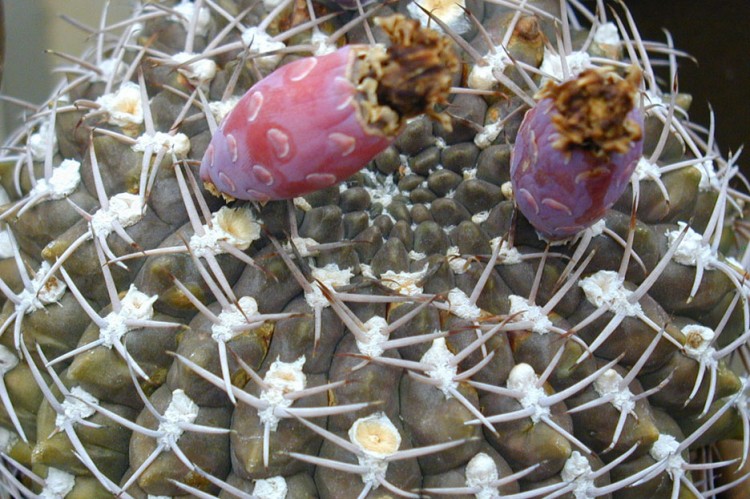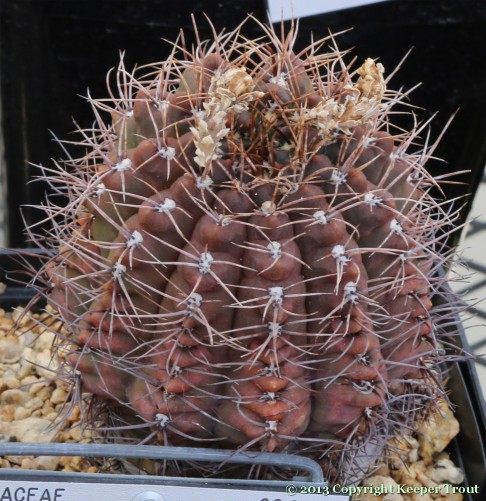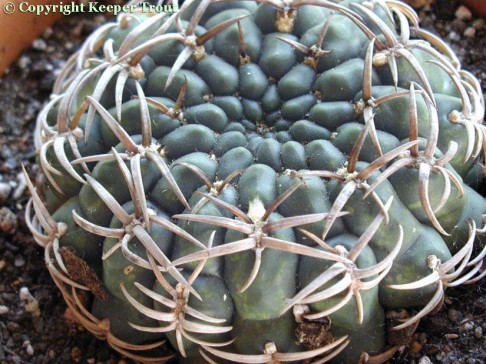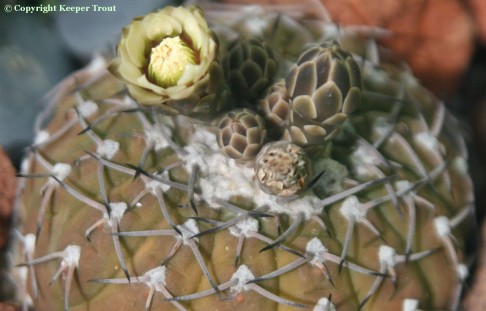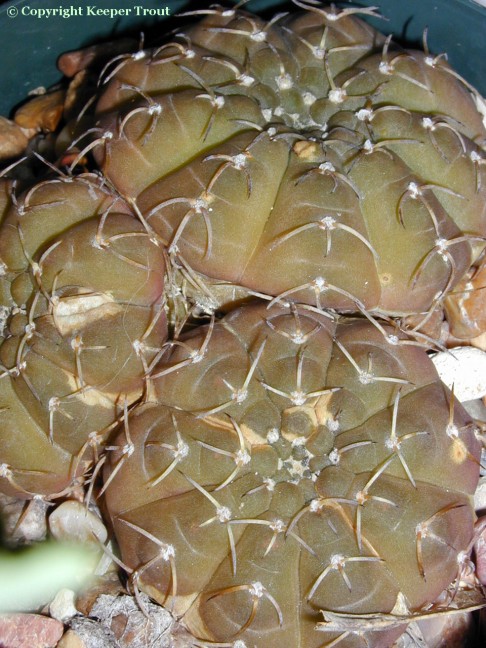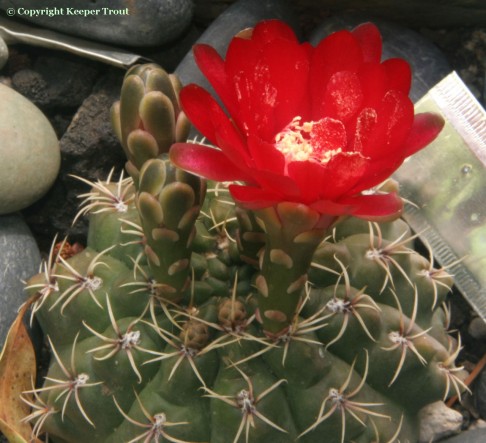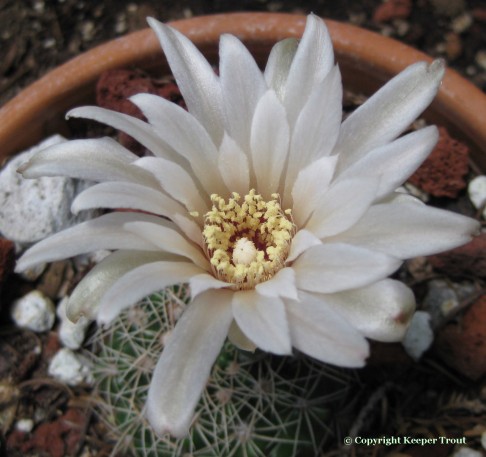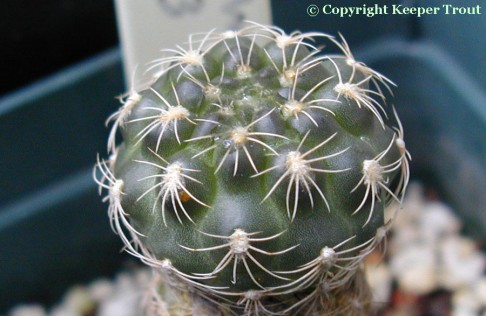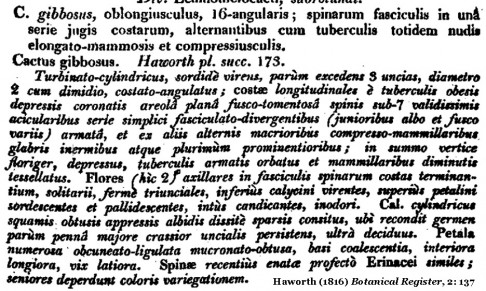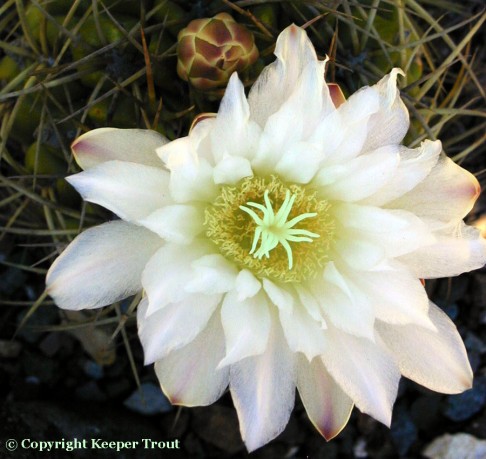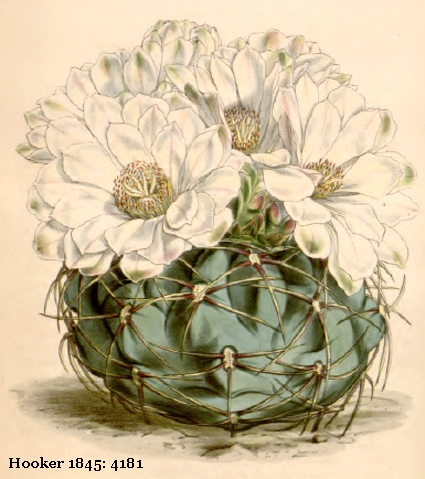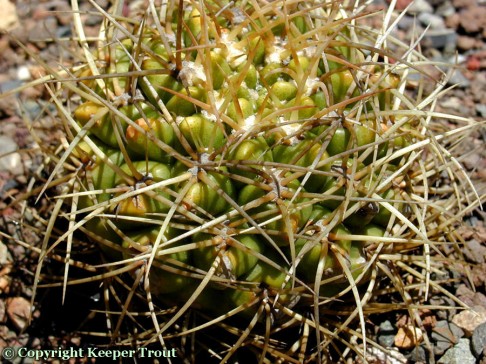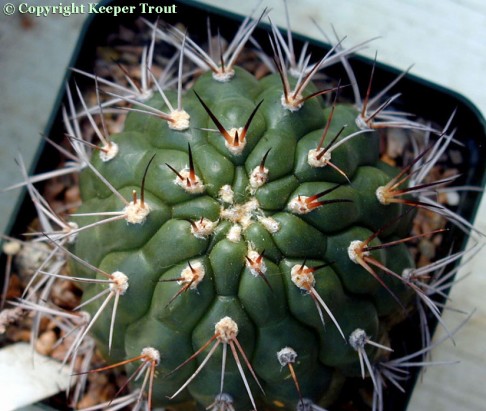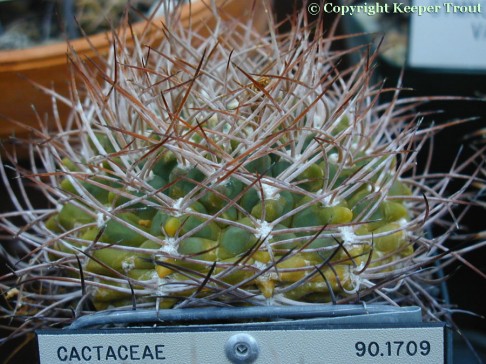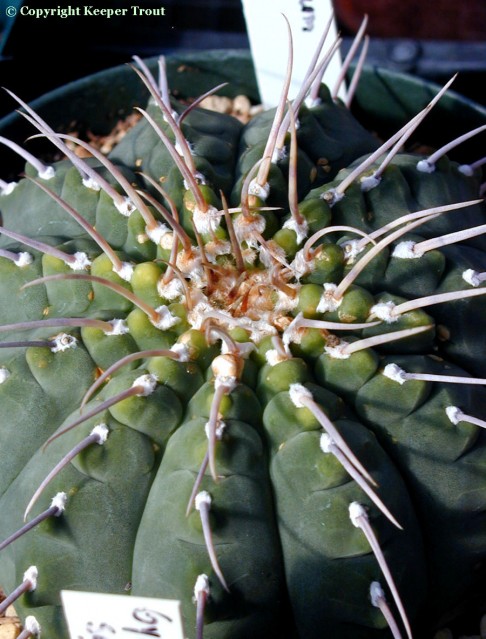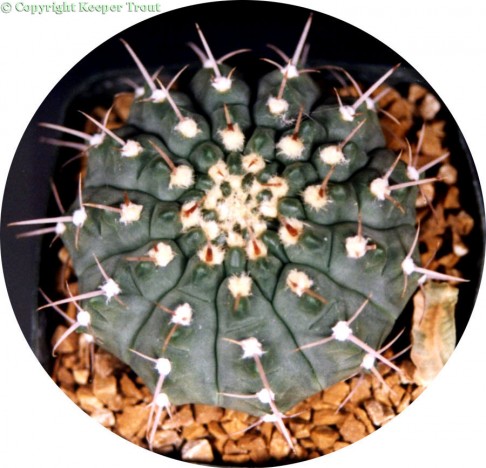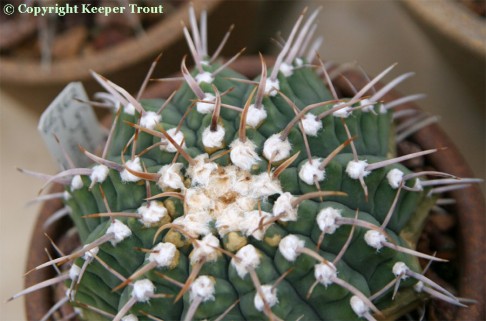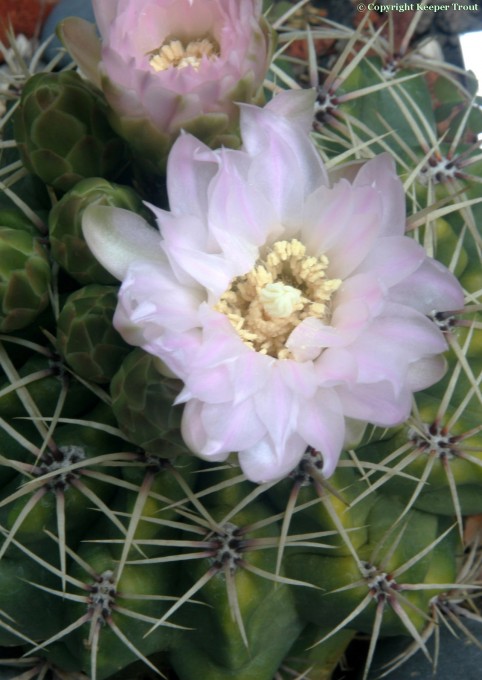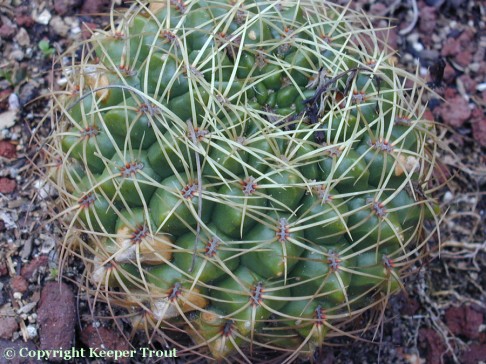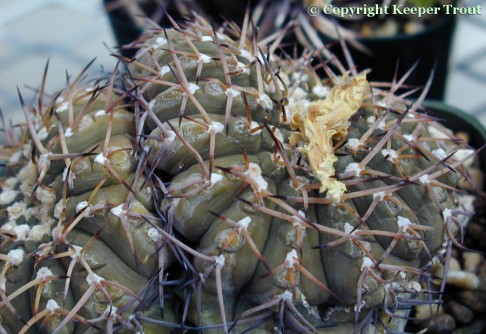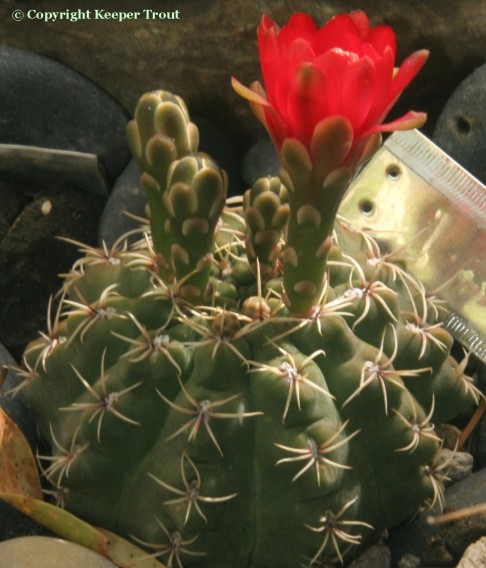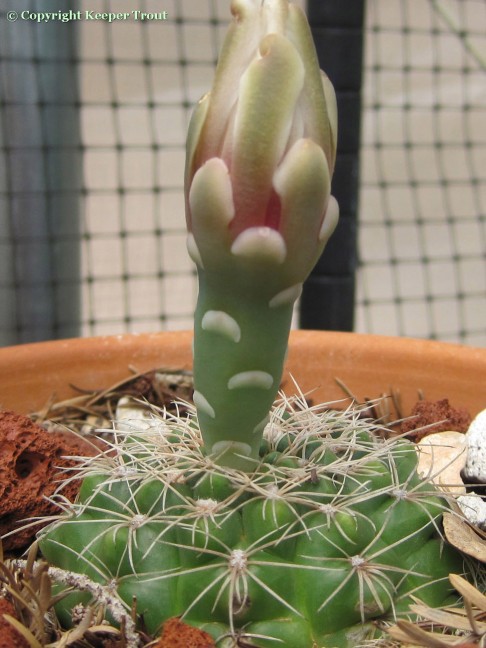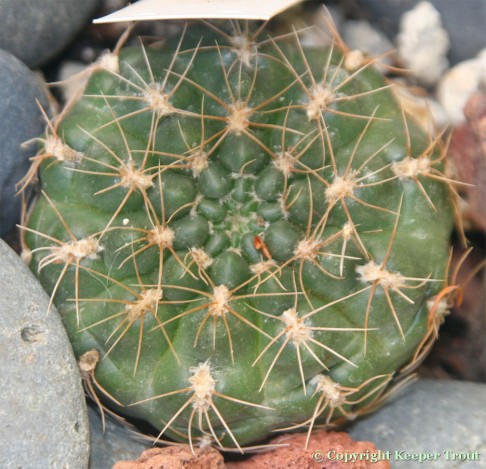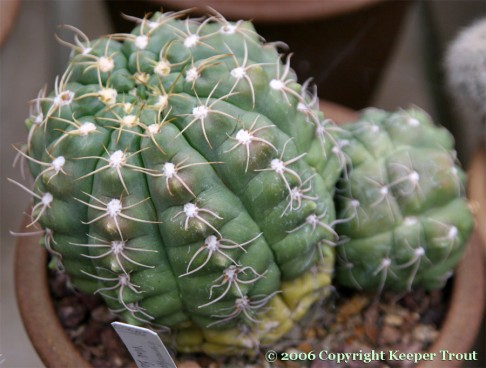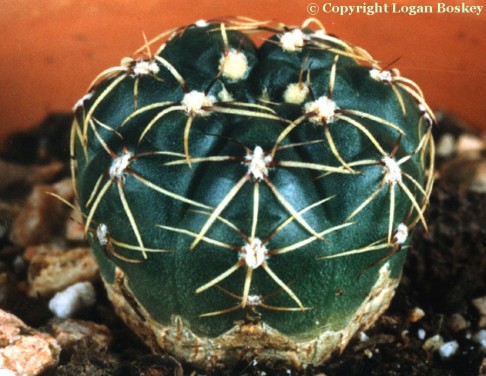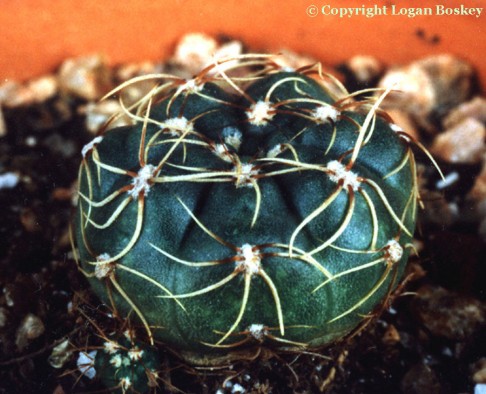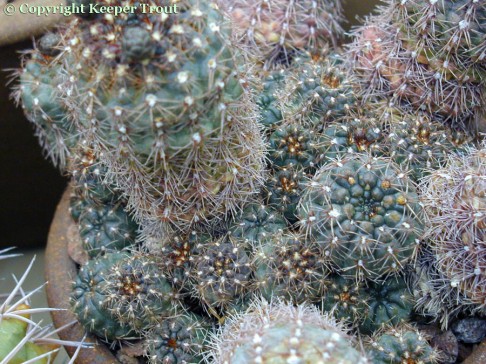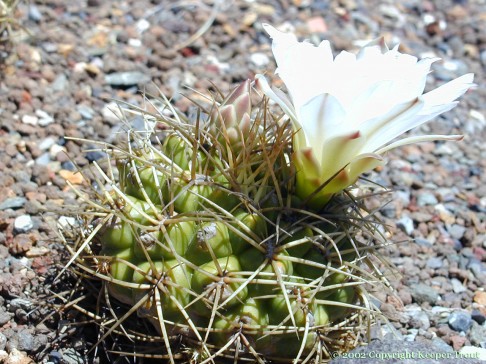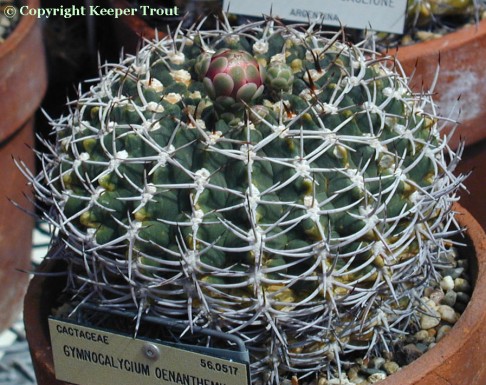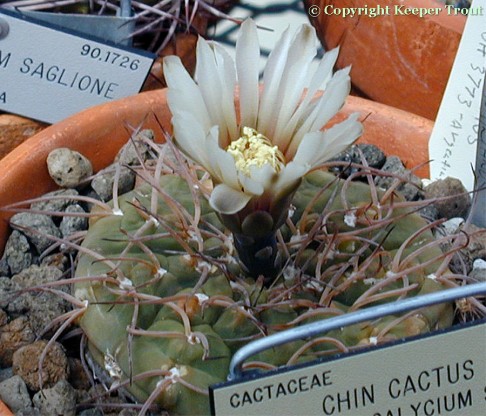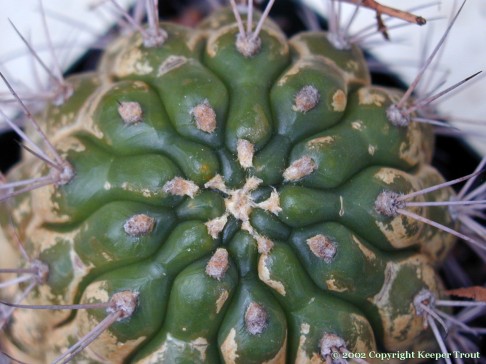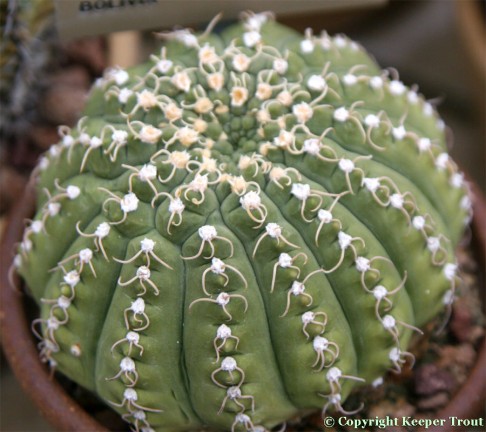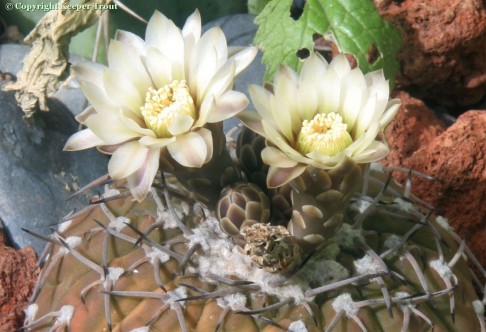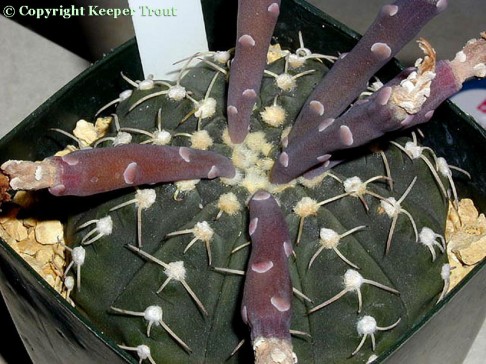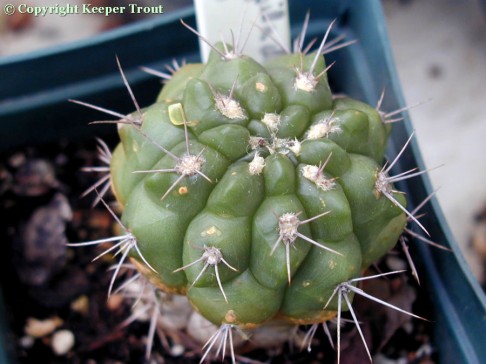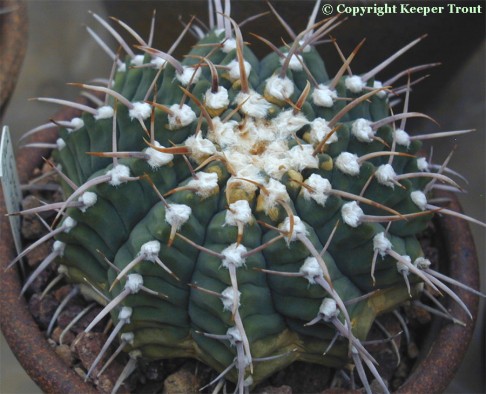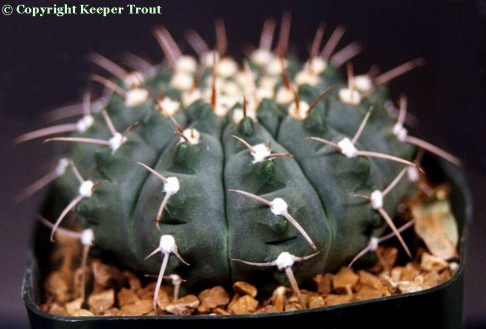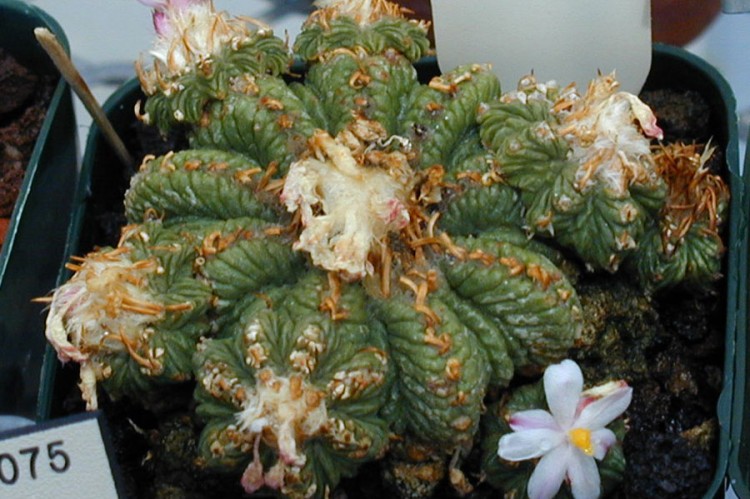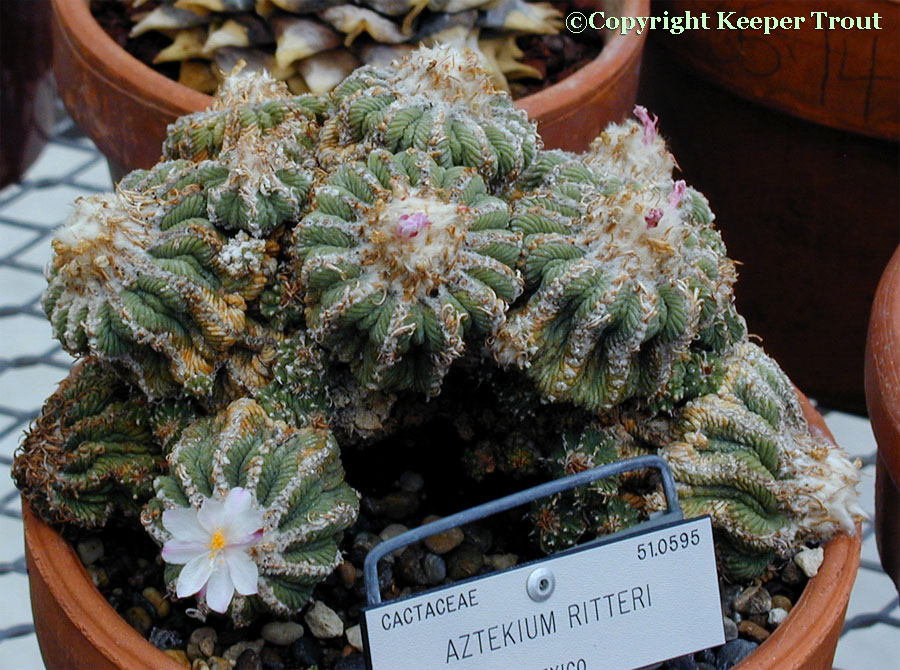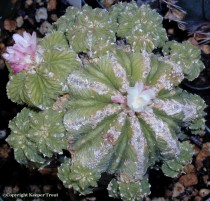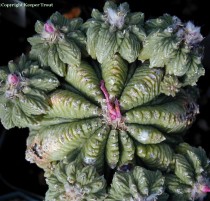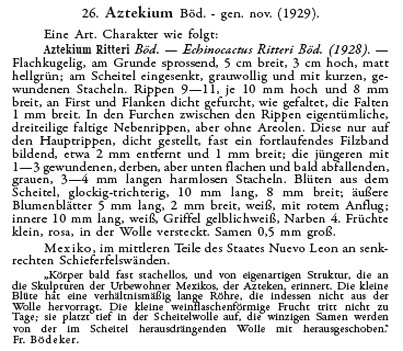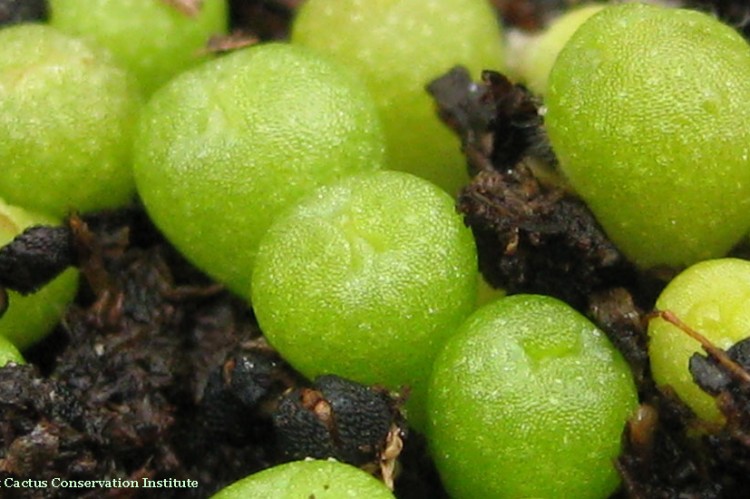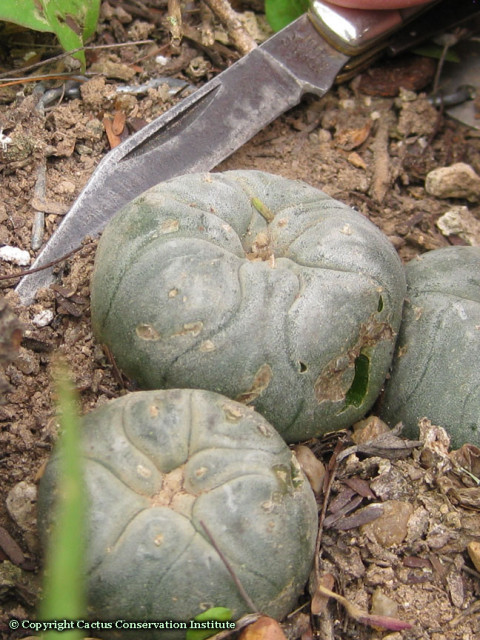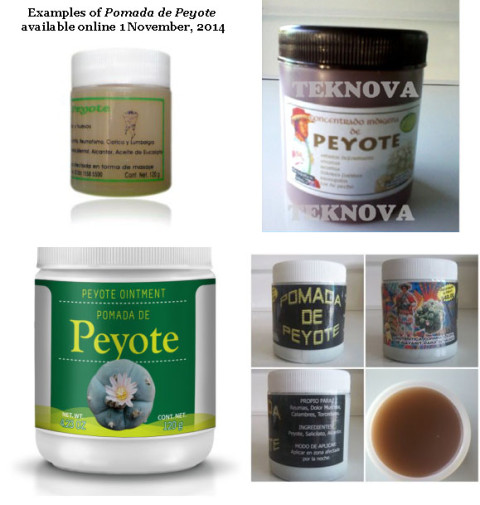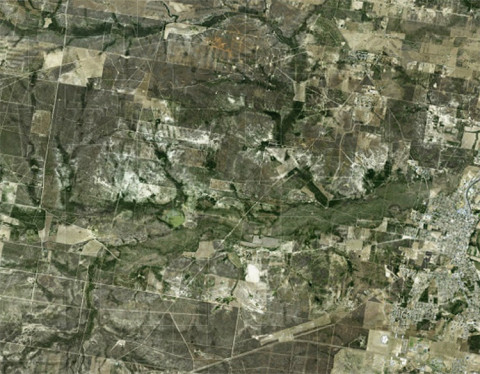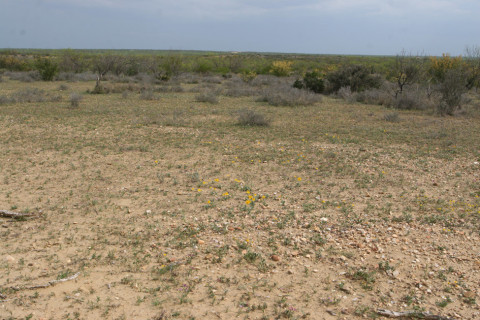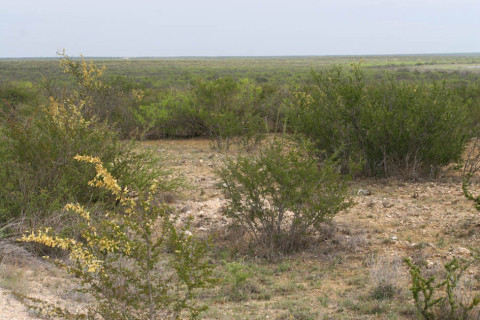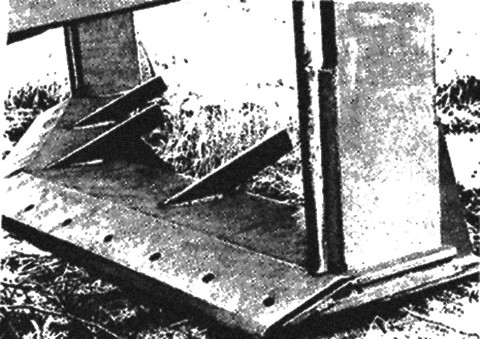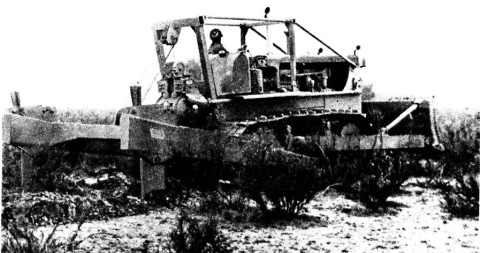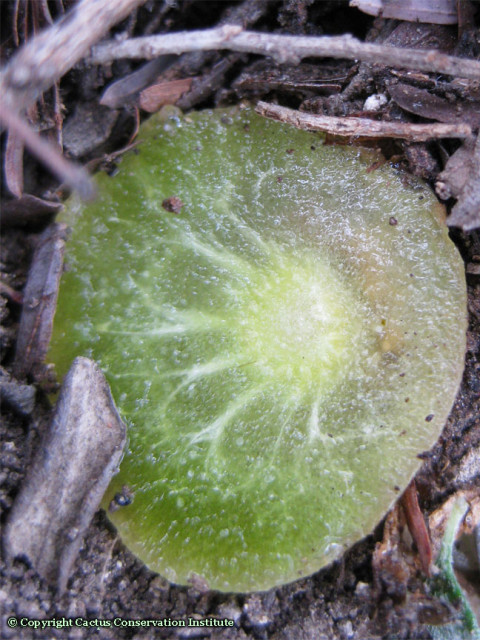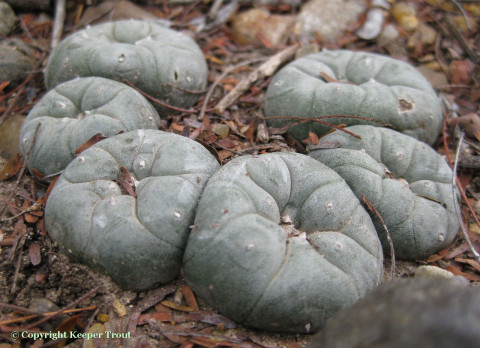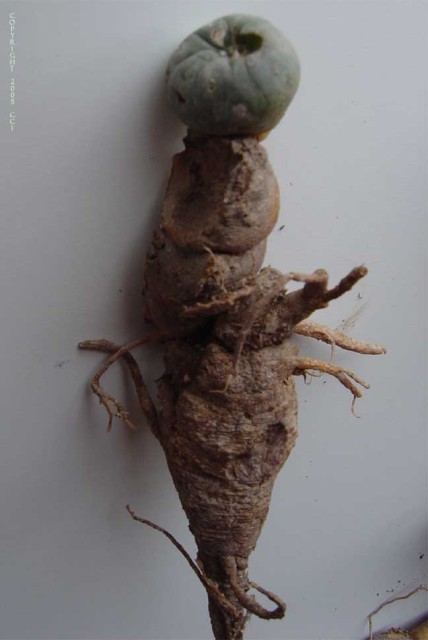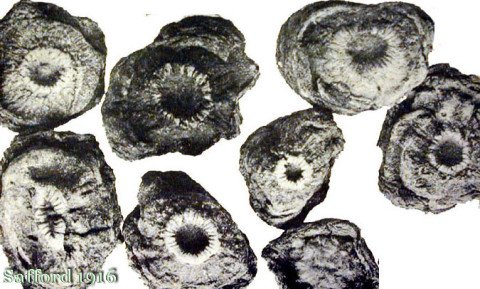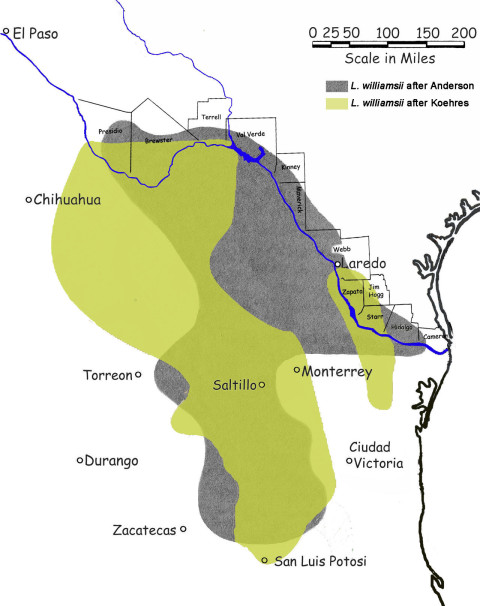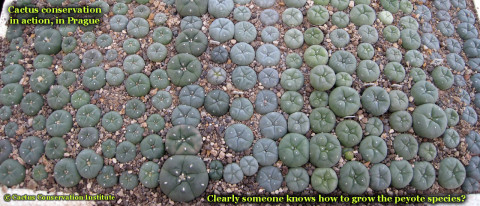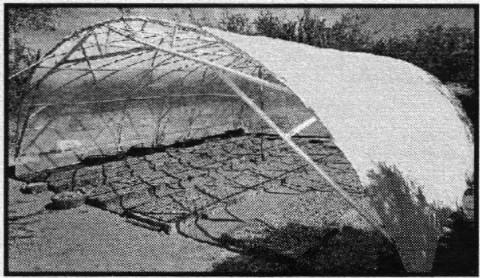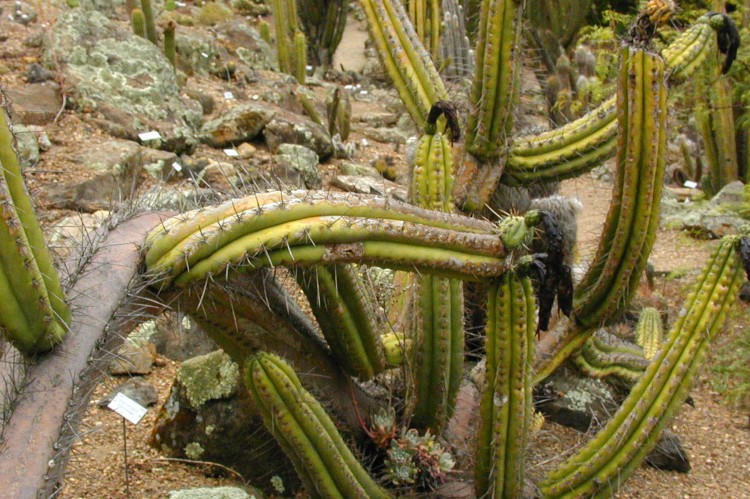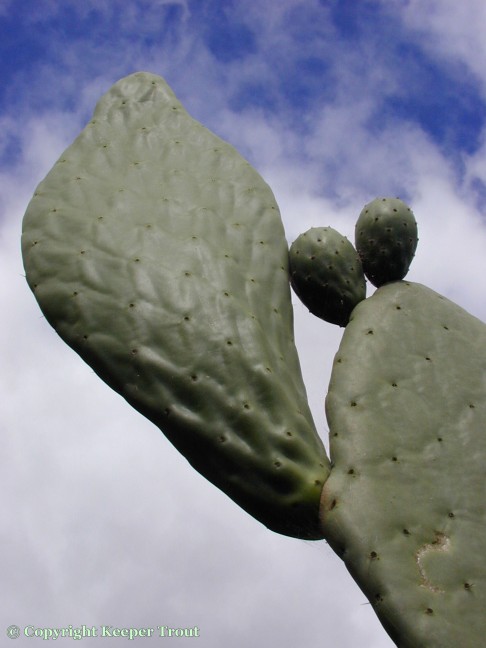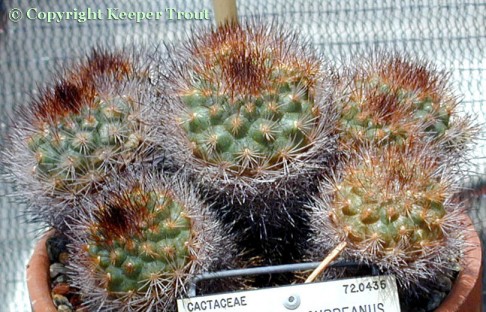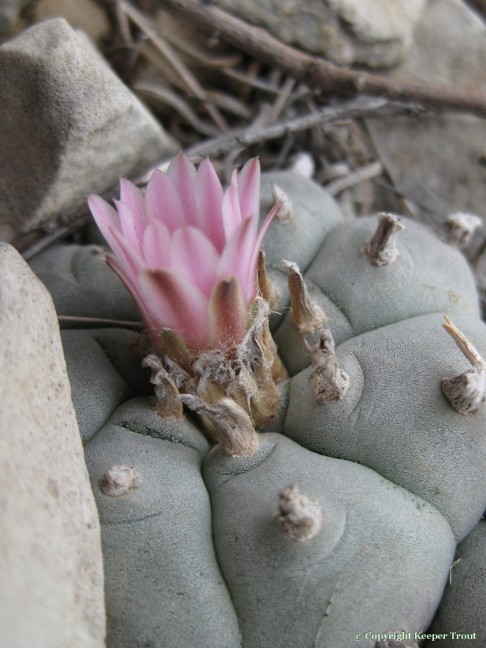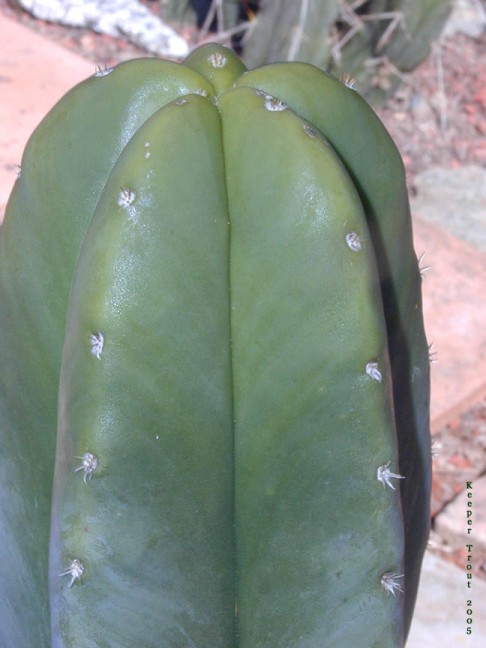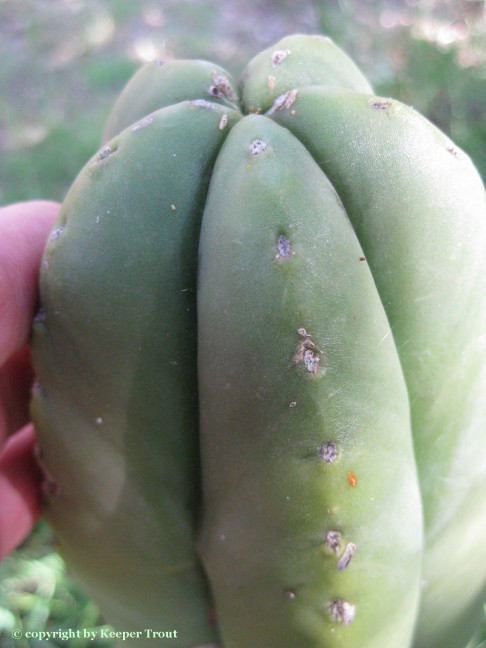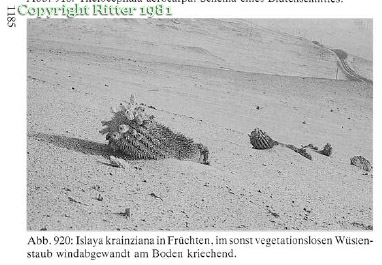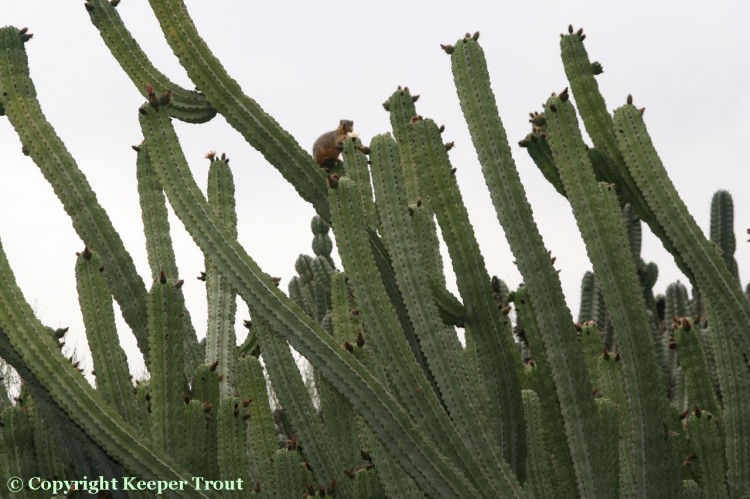This section details only those gymnocalyciums that have been reported to contain mescaline. A more comprehensive treatment of the analytical accounts of the entire genus can be located within Cactus Chemistry By Species_2014_Light which also includes the analytical results listed below.
Some synonyms are included but in most cases the names have been left however they were analyzed as the lumping resulting from the mergers help to obscure some interesting chemistry. These are not being kept separated as an suggestion that they merit recognition, this practice is being employed simply to better preserve and illustrate the published chemical variances. Synonyms are also included so this should be found more helpful than not. Similarly in those analysis involving invalid names, the abandoned names are preserved a,s while those names may be invalid, the analytical results are meaningful as they actually analyzed horticultural plants that physically exist whether they have a good name or not.
Gymnocalycium species
Commonly called “Chin Cactus” due to the “chin” below each areole.
See examples above and below.
Fruit are typically oblong and red (see image at top of page).
Hortus Third. page 530.
Name is from the Greek:
gymnos “bare” and kalyx “bud”; for its bare flower buds.
See also Backeberg 1959 [3: 1695-1786] (includes many pictures.) and Britton & Rose 1922 [3: 152-166] (includes a number of pictures).
Only a representative sampling of the species listed have entries below.
A simple list of the mescaline containing Gymnos:
Gymnocalycium achirasense Till. & Schatzl
Gymnocalycium asterium Ito (now merged into G. stellatum)
[Available varieties include:
v. albispinum
v. nigrispinum
v. paucispinum
v. roseiflorum]
Gymnocalycium baldianum (Speg.) Spegazzini
Gymnocalycium calochlorum (Bödeker) Y. Ito
Gymnocalycium carminanthum Borth & Koop
[var. minimum is also available.]
Gymnocalycium comarapense Backeberg
Gymnocalycium denudatum (L.&O.) Pfeiff.
Gymnocalycium fleischerianum Backeberg (No reference was included)
Gymnocalycium gibbosum (Haworth) Pfeiffer
Gymnocalycium horridispinum Frank
Gymnocalycium leeanum (Hook.) Britton & Rose
Gymnocalycium mesopotamicum Kiessling
Gymnocalycium monvillei (Lemaire) Br. & R.
Gymnocalycium moserianum Schutz
[var. laejera is also available.]
Gymnocalycium netrelianum (Monville) Br. & R.
Gymnocalycium nigriareolatum Backeberg
Gymnocalycium oenanthemum Backeberg
Gymnocalycium paraguayense Schutz
Gymnocalycium quehlianum (Haage) Berger
Available varieties include:
v. albispinum
v. flavispinus
v. kleinianum
v. nigrispinum
Gymnocalycium ragonesii Castellano
Gymnocalycium riojense Fric ex. H.Till. & W.Till
Gymnocalycium riograndense Cardeñas (now Gymnocalycium pflanzii subsp. zegarrae)
Gymnocalycium stellatum Spegazzini
Gymnocalycium striglianum Jeggle
Gymnocalycium triacanthum Backeberg
Gymnocalycium uebelmannianum Rausch
Gymnocalycium valnicekianum Jajó (now Gymnocalycium mostii subsp. valnicekianum)
Gymnocalycium vatteri Buining (now Gymnocalycium ochoterenae subsp. vatteri)
A summary of the published chemistry can be found at the end of the Gymnocalycium examples below.
A handful of Gymnocalycium species:
Gymnocalycium baldianum (Spegazzini) Spegazzini
Small amounts of mescaline reported.
Origin: Argentina (Andalgalá (mountains east of), Catamarca, Cuesta de Portezuelo, Cuesta de Totoral,Hualfin, Sierra Ancasti,Sierra Graciana, Sierra de Guayamba, Sierra de Narvaes, Sierra de Manchao) Collections have been reported from (500m-)900m-1700m(-2000m)
Habitat: Among grasses. (IUCN citing Charles 2009)
86. Echinocactus Baldianus Speg. (n. sp.)
Diag. Hybocactus, parvus globoso -depressus, obscure snbcinerascente-viridis; costis 9-11 latis et obtusissimis, sulco acuto profundiusculo limitatis, fere in tuberculis solutis; areolis parvis: aculéis gracilibus saepius 5, ómnibus marginalibus radiantibus adpressis sordide pallideque ciñereis; floribus apicalibus erectis mediocribus extus obscure glauco-viridibus glaberrimis laxe squamosis, squamis sensim in phylla intense purpurea transeuntibis, laciniis stigmaticis brevibus 6 albo-ochroleucis. Speggazini 1905
Depressed-spherical body, to 7 cm in diameter and 10 cm tall. [Eventually to 3.5 inches in diameter; Anderson 1998]
Epidermis is dark greyish to bluish-green.
9-11 ribs, fewer at first, becoming more distinctly tuberculate.
5-7 pinkish-grey to horn-grey or ash-grey, radial spines. More or less appressed or directed laterally, somewhat darker below at first. Spines are weak and flexible; sometimes twisting.
No centrals.
[1.5 inch wide] flowers are variable; lighter or darker red to a more or less blood-red. [White, pink, orange, red or shades in between; borne in spring.
Flowering can occur for several months. Anderson 1998] Pilbeam notes flowers to be variable as pink through red but proposes that hybridization may be responsible for some of the color forms.
Flowers around Christmas in habitat.
Bears dark green elongated fruit.
Backeberg 1977: page 183.
Pilbeam 1995: pages 43-44, fig 14.
Photos with flower: Anderson 1998: page 80 & Pilbeam 1995: plate 15.
Anderson 1998 claims flowering size (1.5 inches in diameter) can be reached in 12 months from seed and it will handle 10°F briefly.
Listed by IUCN as “Least Concern” as, despite a restricted range and pressure from collection activity, it has a continuous range. Local collection and fire are said to be the primary threats.
Perea, M. & Trevisson, M. 2013. Gymnocalycium baldianum. The IUCN Red List of Threatened Species. Version 2014.2. <www.iucnredlist.org>
External resources:
Gymnocalycium calochlorum (Bödeker) Y.Itô
Small amounts of mescaline reported.
Origin: Argentina (The original collection did not include a locality. Reported to occur at Cordoba, Nono, Villa Bura Borchero, La Mudana, Las Rabonas. Collections have been recorded from 900 and 1000m according to Pilbeam; 800-1500m according to IUCN.)
Habitat: “often buried in crumbling granite, where it can be difficult to find if not in flower or fruit (Charles 2009). It grows in high-altitude grasslands and chaco forest.” IUCN
Cushion forming plant with depressed-spherical cushion-like single heads.
Bodies are grey-green to blue-green to around 6 cm diameter and to 4 cm high.
Around 11 tuberculate ribs with creamy-white felted round areoles.
Up to 9 closely set whitish to pale pinkish-brown radial spines that are thin, wispy, rough, appressed, more or less curving; to 9(-12.5) mm long. No centrals.
Pale pink flowers to 6 cm long, opening only moderately. Produced only from the youngest areoles. Petals are not revolute.
Floral tube is long and of a lighter green according to Backeberg or bluish according to Pilbeam.
Fruit is bluish-green and long-ovoid.
Backeberg 1977 page 184,
and Pilbeam 1995: pages 52-53, Photos as fig. 21 and plates 25 (flowering) & 26 (in habitat),
and Pizzetti 1985 entry #117 (includes picture)
Listed by the IUCN as a species of “Least Concern” due to a perception of it being locally abundant and resistant to disturbances. The IUCN says both “It is very widespread…” and “…the range is not particularly wide,…”
Demaio, P. & Trevisson, M. 2013. Gymnocalycium calochlorum. The IUCN Red List of Threatened Species. Version 2014.2.
Recognized varieties mentioned by Pizzetti (only the first is respected by Pilbeam):
var. proliferum; with larger darker or glacous stems, flowers that open widely and flower segments that curve outward (may be
brownish-white, pink or white; often pink at base.)
var. roseiacanthum; a smaller variety (half the size of the
species). Glaucous green with yellowish rounded areoles and contorted
pinkish spines. Flowers are large and white with red bases. These
plants occur in the Sierra de Córdoba.
Pizzetti recommends protection from intense cold and shady positions when the sun is hottest. Prefers cool weather.
External resources:
Cactus-Art
Gymnocalycium gibbosum (Haworth) Pfeiffer
Presence of mescaline reported but unconfirmed.
Origin: Southern Argentina. [Río Chubut, Río Negro and Chubul Provinces:
Lat. 40-45o S.; La Plata, Mendoza, San Luis]
Pilbeam 1995 mentions the species as being widespread in Argentina “covering a great deal of Patagonia, the provinces La Pampa and Buenos Aires and as far west as Mendoza and reported from southern Argenia, at Chubut, Rio Negro and Santa Cruz; recently by Pilz from Argentina, Abra de la Ventura.” Collections have been reported from 400-500m.
The IUCN cites Hunt et al. 2006 as giving occurrences “at elevations of 0 to 1,000 m“.
Habitat: “monte shrubland and patagonian steppe (estepa patagónica)” “likes the sandy or gravelly alluvial soil along the Río Negro and Río Colorado, where it grows under bushes and other plants (Charles 2009).” IUCN
Solitary glaucous, dull or dark (bluish)green well-armed stems, (Pilbeam: dark green to blue-black or greyish-green”) later sooty or brownish-green, to 10 [-24] inches (12-15 cm) high and 6 inches (10-12 cm) thick. Starts
globular then becomes more cylindrical.
Areoles set 1.5-2 cm apart.
12-14 [-19] strongly tubercled, straight, notched and rounded ribs with lightly sunken round areoles with greyish (Pilbeam describes as brownish-cream) wool. Prominent chins below areoles.
7-12 radial spines, stiff, spreading, needle-shaped to awl-shaped, typically straight but may be slightly curved, and mostly brown. (or light brown with a reddish base.) Up to 3.5 cm long. Nearly spineless at apex.
Can have 1-3 central spines (0-6 according to Pilbeam) but usually they are absent. When present they are often not readily distinguishable from the radial spines.
White (to faintly pink or reddish) flowers to 2-1/2 [to 2-3/4] inches long (6 cm long opening to 6 cm wide). Inner petals are lanceolate. Petals shaded from white to pink. Stamens and stigma are white; stigma has 12 yellowish lobes.
Diurnal flowers in summer.
Produced a club-shaped short, dark-green fruit.
Seldom branches unless injured or grafted, but some varieties do branch freely.
page 530 in Hortus Third
and Backeberg 1977: page 186
and Borg 1937: page 239
and Innes & Glass 1991: page 127 [Includes
picture of flowers]
and Lamb & Lamb 1971: page 654
and Pilbeam 1995: pages 73-76, fig. 37 & 38, plate 47
and Pizzetti 1985 Entry #119. (has color photo)
Listed by IUCN as a species of “Least Concern” due to having no major threats and having a wide range in which it occurs abundantly. ListedIts range includes protected areas.
Demaio, P. & Trevisson, M. 2013. Gymnocalycium gibbosum. The IUCN Red List of Threatened Species. Version 2014.2.
Hortus recognizes:
cv. Ferox has more numerous spines
cv. Nigrum has very dark spines
cv. Schlumbergii has more numerous spines that are stiff pinkish red to amber yellow.
page 530 in Hortus Third
Many varieties exist in both the wild and in cultivation. First described in 1812. Has been known by many names over the years due to its varieties.
Entry #119 in Pizzetti 1985
Pilbeam 1995 mentioned that “Nearly 30 varietal names have been allocated to this species.”
cv. Nobile is said to have a larger sperical stem and longer overlapping spines; white with red base.
Borg 1977 mentions var. caespitosum Hort., var. ferox Lab., var. leucacanthum K.Schum., var. Schlumbergeri K.Schum., var. nobilis K.Schum., and var. leonensis Hildm.
Backeberg 1977 mentions var. leucodictylon (K.Schum.) Y.Ito, var. nigrum Backbg, and var. nobile (Haw.) Y.Ito.
var. rostratum is also commercially available. It is described as having a dark grey stem.
IPNI lists:
v. borthii
v. brachypetalum
f. cerebriforme
var cerebriformis
var. chubutense
ssp ferdinandii
ssp. ferox
ssp. gastonii
var. nigrum
ssp. radekii
ssp. radovanii
This has always been a popular plant and is widely grown.
Innes & Glass recommend indirect light and a 50°F minimum temperature.
Pizzetti describes it as cold tolerant but taking no frost, tolerant of heat and requiring some sun.
I’ve found it to be able to survive frost but typically scarring badly afterwards. In Texas, it was repeatedly attacked by thrips.
[See also Backeberg 1959 [3: 1752-1755] (includes pictures of several varieties, also fig. 1687, page 1756 and fig. 1688, page 1757.) and Backeberg 1977 page 186 and Britton & Rose 1922 [3: 158-159] (picture in fig. 166 page 157.]
Reported analysis:
92.1% water by weight (pH of juice: 4.6-5) Herrero-Ducloux 1930b
Mescaline, Anhalamine & Lophophorine
(all identified by chemical tests)
Mata & McLaughlin 1982 cited Herrero-Ducloux 1930b and Reti 1950 (who also cited Herrero-Ducloux)
[Ott 1993, page 114, cites Der Marderosian 1966; mentioning this is a simple listing of mescaline species, rather than a primary source.]
Štarha et al. 1997 did not observe mescaline to be present. See the alkaloid list further below.
Reti 1950 and Chemical Abstracts 1930 says that Enrique Herrero-Ducloux 1930b isolated small amounts of alkaloids from this cactus which he noted gave chemical reactions similar to those of mescaline [Colorless birefringent crystals, n 1.544, mp 160-162°], and what he thought was probably a mixture of anhalonine and lophophorine [Colorless birefringent crystals, n 1.552, mp 188-190°].
No definitive proof was done and apparently only Dr. Štarha has cared enough to follow through during the 70 years which have passed.
External resources:
Gymnocalycium leeanum (Hooker) Britton & Rose
Presence of mescaline reported but unconfirmed.
Origin: Argentina and Uruguay
Habitat: Grasslands in rocky places and on hills. Also in organic materials among rocks. Sometimes under shrubs. IUCN citing Charles 1009.
Echinocactus Leeanus: depresso-globosus obscure subglauco-v i r i d i s tuberculis subhemisphaericis majusculis obtuse hexahedris mammiformibus confluentibus, in series irregulares subverticales dispositis, areolis ovalibus tomentosis, aculeis subgracilibus quorum subdecem patentibus rectiusculis cum unieo centrali porrecta v i x majore, floribus majusculis pallide flavescentibus. (Hooker 1845)
Bluish-green stems ~3 inches thick. Depressed to spherical. [“rather flattened” Innes & Glass]
~16 ribs, irregular, strongly tubercled (more or less six-sided)
Radial spines about 7-10(-11) needle-shaped, thin, appressed, 1/2 inch long.
Central spine 1 straight and directed outward. Not always present.
Flowers pale yellow [“yellowish-white, 2-2½ in long and high” Innes & Glass] to 2 inches (unisexual).
Blooms in early summer.
Backeberg 1959 [3, pages 1735-1737, (includes pictures of two varieties.)
and Backeberg 1977: page 188
and Britton & Rose 1922: page 154 (picture in fig. 164, page 156)
and Hortus Third: page 530.
and Innes & Glass 1991: page 128 (includes picture of species and var. netrelianum, both with flower)
[Schuster 1990 has photo on p. 128.]
var. brevispinum Backeberg is described from Maldonado, Uruguay. It is said to have much shorter and straighter spines.
var. netrelianum (Monv.) Backeb, (= G. netrelianum (Monv.) Britt. and Rose Hortus Third Page 530. [see entry of G. netrelium]) Backeberg lists separately; G. leeanum var. netrelianum (Uruguay): tubercle said to be broader than high, spines longer [5-8, centrals absent; Backeberg 1977].
Innes & Glass describe var. netrelianum as being slightly more globular with fewer, shorter spines (5-7), usually no centrals and having citron yellow flowers 1.5 to 1.75 inches in diameter.
Listed by IUCN as a species of “Least Concern” due to having a fairly wide range that includes protected areas. Its major threats appear to be from human activity and grazing.
Kiesling, R. 2013. Gymnocalycium reductum. The IUCN Red List of Threatened Species. Version 2014.2. www.iucnredlist.org.
Innes & Glass recommend slight shade and a minimum of 50°F.
Reported chemistry of Gymnocalycium leeanum:
Tyramine (gc),
N-Methyl-tyramine (gc),
Hordenine (ms, gc),
Mescaline (chemical tests; unconfirmed),
Anhalonine (chemical tests)
and Lophophorine (chemical tests)
Mata & McLaughlin 1982 citing DeVries et al. 1971 and Herrero-Ducloux 1930b (Apparently DeVries and coworkerrs did not find mescaline, finding the first three phenethylamines instead.
The UT library is missing the first several issues of both journals. It is unknown to me what variety either DeVries or Herrero-Ducloux used or whether this was either noted or even taken into account.)
External resources:
Cactus-Art
Gymnocalycium multiflorum (Hooker) Britton & Rose
i.e. Nathaniel Lord Britton & Joseph Nelson Rose (1922) Cactaceae, 3: 161, as Gymnocalycium monvillei Pfeiff. ex Britton & Rose.]
Herrero-Ducloux 1932a reported recovering small quantities of a ‘mescaline-like’ alkaloid from this species. Reti notes as occuring in Cordoba and Catamarca in Argentina, also in Brazil, Uruguay and Paraguay.
This species is fairly frequent in cactus collections and is readily available commercially. It is one of the more easily
recognizable Gymnocalycium species.
This report is unconfirmed as it apparently lacks any further work. This species is regarded to be a synonym of Gymnocalycium monvillei which HAS been reported to contain mescaline. See more details under that name.
G. monvillei is listed as being a species of “Least Concern” by the IUCN.
Demaio, P., Lowry, M., Trevisson, M. & Méndez, E. 2013. Gymnocalycium monvillei. The IUCN Red List of Threatened Species. Version 2014.2. <www.iucnredlist.org>.
External resources:
Gymnocalycium riograndense Cardeñas
Mescaline reported in small amounts.
Origin: Bolivia. Along Rio Grande “between the Cordillera de Cochabamba and the plano of the Rio Guarayos”. Pizzetti 1985.
Habitat: (As G. pflanzi) growing in deep rich soils in sunny rocky areas on slopes or under spiny shrubs. Cactus-Art.
Plants broadly spherical, to 6 cm high, to 20 cm diameter [2-1/2 inches tall and up to 8 inches in diameter]. Initially remaining simple but offshooting from base as adults.
Body is glossy, dark green. [The plant in Pizzeti’s photo is not dark]
Around 13 ribs, to 3 cm wide; Tubercles are obtusely conical, separated by transverse dividing lines; a slender conical beak is below the tubercles.
Round areoles covered with white felt when young but later becoming bare.
8(-9) thin-subulate radial spines, to 2.5 cm long; slightly curving.
They are stiff, grey, black-tipped, brownish below. Later becoming brown all over.
No centrals.
Beaker-shaped flowers are white, with a bluish-red throat.
Backeberg 1977 page 193
and Pizzetti 1985 Entry #126 (Has picture.)
Pizzetti recommends mild winter heat.
External resources:
Gymnocalycium valnicekianum Jajó
Mescaline reported in small amounts.
Origin: Argentina (Córdoba & El Zapata). (500-)900-1300(-1500)m.
Habitat: Grows among tall grasses in mossy cracks and cavities in rocky cliffs. Cactus-Art.
Broadly spherical at first, later growing spherical to elongated; up to 30 cm high and 18 cm in diameter, sometimes offsetting. Pilbeam notes it to grow larger in cultivation.
Epidermis is smooth and dark grass-green.
Around 10(-13) ribs with swollen, rounded, chin-like tubercles and elliptical areoles with light grey wool.
Spine are variable in number, 7-15 or more. They are whitish-grey to
dirty white, and thickened below. 1-6 central spines. Spines have darker tips at first.”The plants in habitat are each one different from its neighbours! Some had strong spines others weak, curly, straight, long or short ones and in all different combinations” Cactus-Art
Flowers are white with a reddish throat and reddish striped outer petals; 5 cm dia.
Seeds are matt black.
Backeberg 1977 page 195
Pilbeam 1995: 151-152 (Fig. 97)
Koehres offers var. polycentrale
Schütz also distinguishes var. centrispinum.
IUCN lists Gymnocalycium mostii as a species of “Least Concern” due to there being abundance of plants, no significant threats and occurrence in a protected range.
Demaio, P. & Trevisson, M. 2013. Gymnocalycium mostii. The IUCN Red List of Threatened Species. Version 2014.2. <www.iucnredlist.org>.
External resources:
Gymnocalycium vatteri Buining
Mescaline has been reported in small amounts.
Origin: Argentina (Córdoba, Sierra Grande, near Nono). 800-1000m.
Solitary typically but offesetting around the base with age.
Starting flattened hemisperical at first, growing to 4 cm high and 9 cm in diameter.
Epidermis is matt, olive green.
(8-)11(-16), ribs; up to 2.5 cm across and uo to 12 mm high.
Tubercles are swollen and humped, possessing an acute transverse notch beneath.
Areoles are somewhat depressed, ~5 mm wide with grey wool.
3(-5) [1 or 2, sometimes 3 in Pilbeam) Radial spines are appressed or projecting; Pilbeam notes them standing out in youth but curving towards the body with age. They are up to 2 cm and thicker at their base; horn-colored or a dirty darker color.
Spines on the lower part of the plant are variable in both length and curvature but are fairly stout and also sometimes projecting; other spines may be bent and closely appressed.
White flower with a reddish throat in Backeberg and a brownish-grey throat in Pilbeam. 5 cm. long and 4 cm in diameter.
Glossy, light brown seeds; 1 mm in length.
There is a form with more conspicuously claw-like spines but they can also be irregularly interlacing.
Backeberg 1977: page 195 (Fig. 146)
Pilbeam 1995: 152-153 (Fig. 98)
Hardy to -5°C. Light shading is recommended. Cactus-Art. Pilbeam describes as slow growing.
Koehres offers var. cereiformis
External resources:
All of Dr. Štarha’s values for the next section were determined by GC and/or GC-MS. All of the plants that he analyzed were grown from seed in Czechoslovakian greenhouses.
Reports of mescaline within the Gymnocalycium species
Synonyms are often mentioned but expect them to keep changing as long as humans keep trying to categorize plants.
Gymnocalycium achirasense Till & Schatzl
Tyramine (0.00159% [± 0.00008])
N-Methyltyramine (0.00045% [± 0.00006])
Hordenine (0.00129% [± 0.00006])
Mescaline (0.00007% [± 0.00001])
N-Methylmescaline (0.00013% [± 0.00001])
N,N-Dimethylmescaline (0.00025% [± 0.00002])
Anhalamine (0.00097% [± 0.00001])
Štarha et al. 1998 (% by fresh weight)
[All of Starha’s values in this genus are expressed as % by fresh weight.]
Gymnocalycium asterium Ito
(now merged with Gymnocalycium stellatum)
Tyramine (0.00089% [± 0.00013])
N-Methyltyramine (0.00012% [± 0.00004])
Hordenine (0.00105% [± 0.0001])
Mescaline (0.00013% [± 0.00002])
N-Methylmescaline (0.00031% [± 0.00004])
N,N-Dimethylmescaline (0.0005% [± 0.00004])
O-Methylanhalidine (0.00011% [± 0.00002])
Anhalidine (Trace)
Anhalamine (0.00054% [± 0.00002])
Anhalonidine (Trace)
Pellotine (Trace)
Anhalonine (Trace)
Lophophorine (Trace)
Štarha et al. 1998 (% by fresh weight)
Compare the analysis of G. asterium to that of G. stellatum.
Gymnocalycium baldianum (Spegazzini) Spegazzini
Tyramine (less than 0.0001%)
Hordenine (approximately 0.001%)
Mescaline (less than 0.0001%)
Anhalinine (less than 0.0001%)
Anhalidine (less than 0.0001%)
Anhalamine (less than 0.0001%)
Anhalonidine (less than 0.0001%)
Pellotine (less than 0.0001%)
Anhalonine (less than 0.0001%)
Lophophorine (less than 0.0001%)
Štarha 1996
Reported to contain Betalains as pigments. Wohlpart & Mabry 1968
cited Dreiding 1961
Gymnocalycium calochlorum (Boedecker) Y.Itô
Mescaline (between 0.0001-0.001%)
Tyramine (between 0.0001-0.001%)
N-Methyltyramine (less than 0.0001%)
Hordenine (approximately 0.001%)
N-Methylmescaline (less than 0.0001%)
Anhalinine (less than 0.0001%)
Anhalidine (less than 0.0001%)
Anhalamine (less than 0.0001%)
Anhalonidine (between 0.0001-0.001%)
Pellotine (less than 0.0001%)
Štarha 1996 (% by fresh weight)
Gymnocalycium carminanthum Borth & Koop
Tyramine (0.00007% [± 0.00003])
N-Methyltyramine (Trace)
Hordenine (0.00016% [± 0.00005])
Mescaline (0.00006% [± 0.00005])
N-Methylmescaline (Trace)
N,N-Dimethylmescaline (0.00008% [± 0.00002])
O-Methylanhalidine (0.00007% [± 0.00002])
Anhalamine (0.00088% [± 0.00003])
Anhalonidine (Trace)
Štarha et al. 1998 (% by fresh weight)
Gymnocalycium comarapense Backeberg
Tyramine (Between 0.001-0.001%)
N-Methyltyramine (Less than 0.001%)
Hordenine (Less than 0.001%)
Mescaline (Less than 0.001%)
N-Methylmescaline (Less than 0.001%)
Anhalamine (Less than 0.001%)
Pellotine (Less than 0.001%)
Štarha 1995 (% by fresh weight)
Gymnocalycium denudatum (Link & Otto) Pfeiffer
Tyramine (0.00066% [± 0.00006])
N-Methyltyramine (0.00061% [± 0.00002])
Hordenine (0.00052% [± 0.00005])
Mescaline (Trace)
N-Methylmescaline (0.00008% [± 0.00001])
N,N-Dimethylmescaline (0.00073% [± 0.00005])
O-Methylanhalidine (0.00025% [± 0.00003])
Anhalinine (0.00006% [± 0.00002])
O-Methylanhalonidine (0.0001% [± 0.00002])
Anhalidine (Trace)
Anhalamine (0.00048% [± 0.00002])
Anhalonidine (Trace)
Štarha et al. 1998 (% by fresh weight)
Gymnocalycium fleischerianum Backeberg
(Now considered
Tyramine (0.0001-0.001% dry wt.)
N-Methyltyramine (0.001% dry wt.)
Hordenine (0.0001-0.001% dry wt.)
Mescaline (0.0001-0.001% dry wt.)
N-Methylmescaline (0.0001-0.001% dry wt.)
N,N-Dimethylmescaline (0.0001-0.001% dry wt.)
Anhalamine (0.0001-0.001% dry wt.)
Anhalonidine (0.00001-0.0001% dry wt.)
Štarha 2001c did not include a citation for this information. (G. fleischerianum is included only in his table on page 91 and not in the by species breakdown)
Gymnocalycium gibbosum (Haworth) Pfeiffer
92.1% water by weight (pH of juice: 4.6-5.0) Herrero-Ducloux 1930b
Tyramine (Less than 0.0001%) Štarha et al. 1997
N-Methyltyramine (approximately 0.001%) Štarha et al. 1997
Hordenine (approximately 0.001%) Štarha et al. 1997
Mescaline (unquantified and tentatively identified. Colorless birefringent crystals, n 1.544, mp 160-162o were claimed to show the “reactions of mescaline”) Herrero-Ducloux 1930b. Mescaline was NOT observed by Štarha
et al. 1997.
N-Methylmescaline (Between 0.0001-0.001%) Štarha et al. 1997
N,N-Dimethylmescaline (Less than 0.0001%) Štarha et al. 1997
O-Methylanhalidine (approximately 0.001%) Štarha et al. 1997
Anhalinine (approximately 0.001%) Štarha et al. 1997
O-Methylanhalonidine (approximately 0.001%) Štarha et al. 1997
Anhalidine (Between 0.0001-0.001%) Štarha et al. 1997
Anhalamine No quantification (or accurate identification) attempted; Herrero-Ducloux 1930b [Our source was Reti; CA gives this as Anhalonine. I presently lack the primary paper.] (approximately 0.001%) Štarha et al. 1997
Anhalonidine (Less than 0.0001%) Štarha et al. 1997
Pellotine (Between 0.0001-0.001%) Štarha et al. 1997
Anhalonine (Between 0.0001-0.001%) Štarha et al. 1997
Lophophorine No quantification (or accurate identification) attempted; Herrero-Ducloux 1930b. Between 0.0001-0.001%: Štarha et al. 1997
Gymnocalycium horridispinum Frank
Mescaline (between 0.0001-0.001%)
Tyramine (approximately 0.001%)
N-Methyltyramine (less than 0.0001%)
Hordenine (approximately 0.001%)
N-Methylmescaline (less than 0.0001%)
Anhalinine (less than 0.0001%)
Pellotine (less than 0.0001%)
Štarha 1996 (% by fresh weight)
Gymnocalycium leeanum (Hooker) Br. & R.
[Now considered
Anhalonine (Unconfirmed) Herrero-Ducloux 1930b
Not observed by DeVries et al. 1971
Hordenine (%?) DeVries et al. 1971
Lophophorine (Unconfirmed) Herrero-Ducloux 1930b
Not observed by DeVries et al. 1971
Mescaline (Unconfirmed) Herrero-Ducloux 1930b
Not observed by DeVries et al. 1971
N-Methyltyramine (?%) DeVries et al. 1971
Tyramine (0.00583%) DeVries et al. 1971
Gymnocalycium mesopotamicum Kiessling
Tyramine (Trace)
N-Methyltyramine (Trace)
Hordenine (Trace)
Mescaline (Trace)
N-Methylmescaline (Trace)
N,N-Dimethylmescaline (0.00279% [± 0.0005])
Anhalamine (0.0019% [± 0.00028])
Anhalonidine (0.00005% [± 0.00003])
Štarha et al. 1998 (% by fresh weight)
Gymnocalycium monvillei (Lemaire) Britton & Rose
Tyramine (Between 0.0001-0.001%)
N-Methyltyramine (Between 0.0001-0.001%)
Hordenine (Approximately 0.001%)
Mescaline (Less than 0.0001%)
N-Methylmescaline (Less than 0.0001%)
N,N-Dimethylmescaline (Less than 0.0001%)
O-Methylanhalidine (Less than 0.0001%)
Anhalinine (Less than 0.0001%)
O-Methylanhalonidine (Less than 0.0001%)
Anhalidine (Less than 0.0001%)
Anhalamine (Less than 0.0001%)
Anhalonidine (Between 0.0001-0.001%)
Pellotine (Between 0.0001-0.001%)
Anhalonine (Between 0.0001-0.001%)
Lophophorine (Less than 0.0001%)
Štarha et al. 1997 (% by fresh weight)
Gymnocalycium moserianum Schutz
Tyramine (0.00077% [± 0.0001])
N-Methyltyramine (0.0001% [± 0.00003])
Hordenine (0.00011% [± 0.00003])
Mescaline (0.00007% [± 0.00001])
N-Methylmescaline (0.00151% [± 0.00015])
N,N-Dimethylmescaline (0.00071% [± 0.00006])
O-Methylanhalidine (0.00007% [± 0.00001])
Anhalinine (0.00007% [± 0.00001])
O-Methylanhalonidine (0.00007% [± 0.00001])
Anhalidine (0.00007% [± 0.00001])
Anhalamine (0.00215% [± 0.00014])
Anhalonidine (0.00014% [± 0.00003])
Pellotine (0.00012% [± 0.00003])
Anhalonine (Trace)
Lophophorine (Trace)
Štarha et al. 1998 (% by fresh weight)
Gymnocalycium multiflorum
(Now considered to be at least partially a synonym with Gymnocalycium monvillei.)
Herrero-Ducloux 1932a reported recovering small quantities of a ‘mescaline-like’ alkaloid from this species.
This report for this cactus species presently lacks confirmation.
Gymnocalycium netrelianum Britton & Rose
Tyramine (Less than 0.001%)
Hordenine (Between 0.0001-0.001%)
Mescaline (Between 0.0001-0.001%)
N-Methylmescaline (Less than 0.001%)
Pellotine (Less than 0.001%)
Štarha 1995a (% by fresh weight)
Gymnocalycium nigriareolatum Backeberg
Tyramine (0.00047% [± 0.00005])
N-Methyltyramine (0.00008% [± 0.00002])
Hordenine (0.0014% [± 0.00006])
Mescaline (0.00006% [± 0.00002])
N-Methylmescaline (0.00006% [± 0.00001])
N,N-Dimethylmescaline (0.00009% [± 0.00002])
O-Methylanhalidine (0.00012% [± 0.00006])
Anhalamine (0.00019% [± 0.00004])
Anhalonidine (0.00008% [± 0.00002])
Štarha et al. 1998 (% by fresh weight)
Gymnocalycium oenanthemum Backeberg
Tyramine (Between 0.0001-0.001%)
N-Methyltyramine (Less than 0.0001%)
Hordenine (approximately 0.001%)
Mescaline (Less than 0.0001%)
N-Methylmescaline (Less than 0.0001%)
N,N-Dimethylmescaline (Less than 0.0001%)
O-Methylanhalidine (Less than 0.0001%)
O-Methylanhalonidine (Less than 0.0001%)
Anhalidine (Less than 0.0001%)
Anhalamine (Less than 0.0001%)
Anhalonidine (Between 0.0001-0.001%)
Pellotine (Between 0.0001-0.001%)
Anhalonine (Less than 0.0001%)
Lophophorine (Less than 0.0001%)
Štarha et al. 1997 (% by fresh weight)
Gymnocalycium paraguayense Schutz
Tyramine (0.00047% [± 0.00004])
N-Methyltyramine (0.00104% [± 0.00014])
Hordenine (0.00043% [± 0.00008])
Mescaline (0.00011% [± 0.00006])
N-Methylmescaline (0.00041% [± 0.0001])
N,N-Dimethylmescaline (0.00427% [± 0.00032])
Anhalamine (0.00505% [± 0.0005])
Anhalonidine (0.00017% [± 0.00006])
Štarha et al. 1998 (% by fresh weight)
Gymnocalycium quehlianum (Haage) Berg.
Tyramine (Between 0.0001-0.001%)
N-Methyltyramine (Between 0.0001-0.001%)
Hordenine (approximately 0.001%)
Mescaline (Less than 0.0001%)
N-Methylmescaline (Less than 0.0001%)
N,N-Dimethylmescaline (Less than 0.0001%)
Anhalinine (Less than 0.0001%)
O-Methylanhalonidine (Between 0.0001-0.001%)
Anhalonidine (Less than 0.0001%)
Pellotine (Less than 0.0001%)
Anhalonine (Less than 0.0001%)
Lophophorine (Less than 0.0001%)
Štarha et al. 1997 (% by fresh weight)
Gymnocalycium ragonesii Cast.
Tyramine (0.00009% [± 0.00002])
N-Methyltyramine (0.00005% [± 0.00001])
Hordenine (0.0035% [± 0.00014])
Mescaline (Trace)
N-Methylmescaline (Trace)
N,N-Dimethylmescaline (Trace)
O-Methylanhalidine (0.00048% [± 0.00003])
Anhalinine (0.00109% [± 0.00018])
O-Methylanhalonidine (0.00007% [± 0.00001])
Anhalidine (0.00006% [± 0.00001])
Anhalonidine (Trace)
Pellotine (Trace)
Štarha et al. 1998 (% by fresh weight)
Gymnocalycium riograndense Cardeñas
(Now Gymnocalycium pflanzii subsp. zegarrae)
Tyramine (Between 0.0001-0.001%)
N-Methyltyramine (Less than 0.001%)
Hordenine (Less than 0.001%)
Mescaline (Between 0.0001-0.001%)
N-Methylmescaline (Less than 0.001%)
Anhalinine (Less than 0.001%)
Anhalidine (Less than 0.001%)
Anhalonidine (Less than 0.001%)
Pellotine (Less than 0.001%)
Anhalonine (Less than 0.001%)
Lophophorine (Less than 0.001%)
Štarha 1995a (% by fresh weight)
Gymnocalycium riojense Fric ex H.Till & W.Till
Tyramine (0.001% dry wt.)
N-Methyltyramine (0.00001-0.0001% dry wt.)
Hordenine (0.001% dry wt.)
Mescaline (0.00001-0.0001% dry wt.)
N-Methylmescaline (0.00001-0.0001% dry wt.)
Anhalinine (0.00001-0.0001% dry wt.)
O-Methylanhalonidine (0.00001-0.0001% dry wt.)
Pellotine (0.00001-0.0001% dry wt.)
Anhalonidine (0.00001-0.0001% dry wt.)
Štarha 2001c cited Štarha 2001a
Gymnocalycium stellatum Spegazzini
Tyramine (Between 0.0001-0.001%)
N-Methyltyramine (Less than 0.0001%)
Hordenine (approximately 0.001%)
Mescaline (Less than 0.0001%)
N-Methylmescaline (Between 0.0001-0.001%)
N,N-Dimethylmescaline (Less than 0.0001%)
Anhalinine (Between 0.0001-0.001%)
O-Methylanhalonidine (Less than 0.0001%)
Anhalamine (Less than 0.0001%)
Anhalonidine (Between 0.0001-0.001%)
Pellotine (Between 0.0001-0.001%)
Anhalonine (Between 0.0001-0.001%)
Lophophorine (Less than 0.0001%)
Štarha et al. 1997 (% by fresh weight)
Gymnocalycium striglianum Jeggle
Tyramine (Less than 0.001%)
Hordenine (Less than 0.001%)
Mescaline ( “readily apparent” at around 0.001%)
N-Methylmescaline ( “readily apparent” at around 0.001%)
Anhalinine (Less than 0.001%)
Anhalidine (Less than 0.001%)
Anhalamine ( “readily apparent” at around 0.001%)
Anhalonidine (Less than 0.001%)
Pellotine ( “readily apparent” at around 0.001%)
Anhalonine (Less than 0.001%)
Lophophorine (Less than 0.001%)
Štarha 1995a (% by fresh weight)
Gymnocalycium triacanthum Backeberg
Tyramine (Trace)
N-Methyltyramine (0.00005% [± 0.00001])
Hordenine (0.00054% [± 0.00004])
Mescaline (Trace)
N-Methylmescaline (Trace)
N,N-Dimethylmescaline (Trace)
O-Methylanhalidine (0.00015% [± 0.00001])
Anhalinine (0.00014% [± 0.00001])
Anhalidine (Trace)
Anhalonidine (0.0006% [± 0.00001])
Štarha et al. 1998 (% by fresh weight)
Gymnocalycium uebelmannianum Rausch
Tyramine (Between 0.0001-0.001%)
N-Methyltyramine (Between 0.0001-0.001%)
Hordenine (Between 0.0001-0.001%)
Mescaline (Between 0.0001-0.001%)
N-Methylmescaline (Less than 0.0001%)
N,N-Dimethylmescaline (Less than 0.0001%)
O-Methylanhalidine (Less than 0.0001%)
Anhalinine (Between 0.0001-0.001%)
O-Methylanhalonidine (Between 0.0001-0.001%)
Anhalidine (Less than 0.0001%)
Anhalamine (Between 0.0001-0.001%)
Anhalonidine (Between 0.0001-0.001%)
Pellotine (Between 0.0001-0.001%)
Anhalonine (Less than 0.0001%)
Lophophorine (Less than 0.0001%)
Štarha et al. 1997 (% by fresh weight)
Gymnocalycium valnicekianum Jajó
(now Gymnocalycium mostii subsp. valnicekianum)
Tyramine (Between 0.0001-0.001%)
N-Methyltyramine (Less than 0.001%)
Hordenine ( “readily apparent” at around 0.001%)
Mescaline (Less than 0.001%)
Anhalinine (Less than 0.001%)
Anhalonidine (Between 0.0001-0.001%)
Pellotine (Less than 0.001%)
Anhalonine (Less than 0.001%)
Lophophorine (Less than 0.001%)
Štarha 1995a (% by fresh weight)
Gymnocalycium vatteri Buining
(now Gymnocalycium ochoterenae subsp. vatteri, or not; depending upon with whom you want to agree.)
Mescaline (between 0.0001-0.001%)
Tyramine (approximately 0.001%)
N-Methyltyramine (between 0.0001-0.001%)
Hordenine (approximately 0.001%)
N-Methylmescaline (between 0.0001-0.001%)
Anhalinine (approximately 0.001%)
Anhalidine (less than 0.0001%)
Anhalonidine (between 0.0001-0.001%)
Pellotine (between 0.0001-0.001%)
Anhalonine (less than 0.0001%)
Lophophorine (less than 0.0001%)
Štarha 1996 (% by fresh weight)
Parting comment on the genus Gymnocalycium and South American globulars:
It is puzzling that this large genus and area has been neglected for so many years, in light of the intense academic interest which has intermittently surrounding such plants.The work of Dr. Štarha underscores the need for more in depth work. While the reported concentrations overall are low, this is in line with the majority of cacti tested; the high mescaline producers are only sporadically represented and apparently difficult to predict. Štarha’s results are encouraging despite low values.
Considering how many different Gymnocalycium species are readily available, how easy they are to grow, how often this is mentioned in the literature and how many of the larger flat species actually resemble Peyote in color and appearance, it is mind boggling that more people have not pursued further chemical work in this fascinating and attractive group.
G. platense and G. riograndensis have long been suggested as probable mescaline containing species but, as far as it can be determined, this was implied solely by morphology as no actual chemical work had been done. More recently, Dr. Štarha did indeed find small amounts of mescaline in the latter.
An interesting mention is made of globular cacti in Margaret Ashley Towle 1961. Her reference, Eugenio Yácovleff & Fortunato L. Herrera 1934, mention Lobivia (L. corbula), Mammillaria (M. herrerae) (equating these first two) and Melocacti in passing, during their discussion of the many varied forms of cacti found depicted in ceramic designs. (pages 319-320, ceramic design examples also on page 321). [Their reference to Melocacti was in regards to the Peruvian species which form distinct Cereus-like columns somewhat resembling Neoraimondia and Armatocereus species but it should be mentioned that most Melocacti exist as fairly globular plants.]
Some types of globular cacti are clearly depicted. While mescaline has not yet been reported from these plants, many Lobivia, Mammillaria, Melocacti, and Echinopsis species, as well as additional non-mescaline containing Gymnocalyciums, have all been reported to contain alkaloids.
I would suggest more representative species be examined for all.

